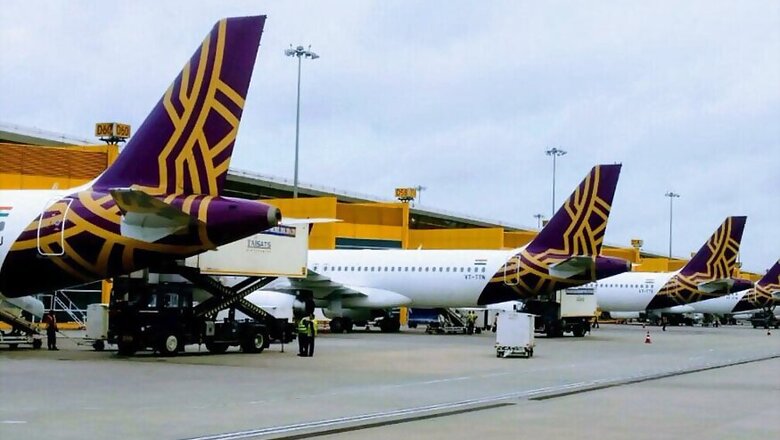
views
The Narendra Modi government recently announced the privatisation of 25 airports. But the move fails to address one of the core challenges of Indian aviation, that is, airport capacity. While the country has a total of 449 airports, metro airports continue to be key to aviation traffic with 61 per cent domestic and 73 per cent international traffic still originating from the six metro cities of Delhi, Mumbai, Bengaluru, Hyderabad, Kolkata and Chennai.
This poses a dilemma for the airline planners as networks have to cover these cities and yet are constrained by the ability to add flights due to non-availability of slots and parking. Peak slots across the metro cities are taken and parking space is reaching its saturation. A new runway in Bengaluru towards the end of this year will ease some constraint, but the system capacity remains a challenge. This also means a forced dispersal of capacity towards non-metro and Tier 2 cities which are also struggling with the airport capacity.
Lack of Integrative Approach
The poor capacity planning is also a result of lack of an integrative approach. Planning is being done at the airport level, let alone at a city level or on a country level. While experts may argue that this is exactly how it is done overseas, the fact that is overlooked is that Indian aviation is still in an evolutionary phase. Thus the planning process has to incorporate elements that are extremely dynamic in nature: from immigration patterns and competing modes of transport to land acquisition and weather patterns. When not done so, it often has a contradictory consequence.
Take, for instance, the Pakyong Airport which provided air-connectivity to Sikkim. The airport was planned and constructed but it would seem that the cloud base and weather patterns were not incorporated, thereby making it a VFR (Visual Flight Rules) airfield only.
No landing aids are installed thus as the weather hits, airlines are forced to cancel flights. The only operator to the airport has suspended flights indefinitely as of June 2019. Similarly, Bengaluru airport spent a significant amount of capex, but only built the current runway to be CAT-I compliant which has consequences for passengers and airlines alike when fog patterns hit.
Airports Cannot be Looked at in Isolation
The challenge of capacity planning also depends on how one looks at airports in a broader context. Airports, after all, are connectivity nodes for respective cities. Planners thus have to factor in the urbanisation trends as well into the overall master plan. This is simply not being done. Take, for example, items such as intermodal connectivity, alternate means of transport, traffic flows to/from the airport and one immediately sees the glaring inconsistencies.
For instance, Mumbai has two terminals T1 and T2 but these are not well-connected, neither on the land-side nor on the air-side. This then poses operational and commercial challenges.
Similarly, Delhi airport, as of now, has some airlines that have to split operations between three terminals, making for higher costs, lower efficiency and confusion for travellers. Interestingly, both these airports have seen significant expansion and elements such as these should have been planned for. Finally, planning also has to be market-specific, cross-functional and collaborative. This challenge is ongoing.
Force-fitting Western Models Leads to Problems
Airport master-planning requires expertise and also an understanding of the Indian market and its prospects. Several firms pitch projects that highlight how a particular city will be the most vibrant hub-airport in the future. They support this case with the geo-strategic location of India and the traffic trends. Often, what is overlooked is that a hub requires several elements, including a strong anchor carrier with a specific business model. Attempting to copy the aviation success of airports such as Singapore, Dubai and London is fraught with inconsistencies – yet several airport pitches and plans call for doing just that.
Force-fitting western models is widely accepted in the market, and sadly, it is the flying public that has to pay for these mistakes. Take, for example, something as simple as laying carpet at airports or building airports using large amounts of glass and steel. Both these concepts are derived from countries with cold climates and are simply not suited for India.
Similarly, when one looks at the terminal design, there is a focus on maximising retail space – one of the factors leading to expensive terminal buildings. In many cases, the retail spaces are expanded while compromising on passenger space. Other design concepts such as a central atrium, walkways, split level food-courts etc. are also force-fitted to the Indian market. The end result is that for something as simple and integral to India as a cup of tea, Indian airports often force the passenger to pay Rs 150 while forcing passengers to navigate their way through a maze of shops and elevators. The only way such a model sustains itself is due to the airport operator having a complete monopoly , which consequently impacts capacity.
India has witnessed tremendous aviation growth in the past decade. Airports are bursting at the seams and the capacity lags far behind the demand. Financial year 2018-19 saw 275 million travellers, 2.5 million air transport movements and 3.5 million metric tonnes of cargo fly in and out of Indian airports.
This number is only going to grow. With a 300 million strong middle-class, low air travel penetration and an increasing propensity to spend, India is targeting 500 million passenger trips in the next 20 years.
Forecasts estimate that India will be the third largest aviation market within the next 6 to 7 years. Yet, when one looks at the airport capacity, it is clear that a capacity crisis is looming large. It is a crisis that requires immediate action.
(The author led the advisory and research teams at Centre for Aviation (CAPA). Views expressed are personal.)




















Comments
0 comment